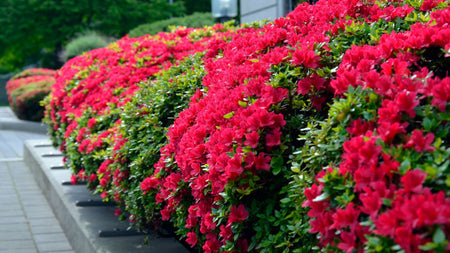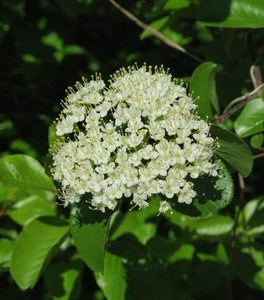
Images Depict Mature Plants
Shasta Viburnum Shrubs for Sale Online
Shasta Viburnum (Viburnum plicatum f. tomentosum 'Shasta') is a stunning, deciduous shrub known for its wide-spreading horizontal branches and showy, layered white blooms. Thriving in USDA Hardiness Zones 5-8, this viburnum grows to a mature size of 6-8 feet tall and 8-10 feet wide, making it an impressive choice for garden borders, hedges, or as a specimen plant. In late spring, Shasta Viburnum produces large, flat clusters of white flowers that cover the branches, creating a striking, tiered effect reminiscent of a lacecap hydrangea. These blooms attract pollinators like bees and butterflies, adding ecological value to your landscape.
As the season progresses, Shasta Viburnum produces clusters of bright red berries that ripen to a deep black, providing food for birds and wildlife throughout the summer. Its dark green foliage creates a beautiful backdrop for the flowers and berries and turns vibrant shades of red and purple in the fall, adding seasonal interest. This viburnum's wide-spreading habit and multi-season appeal make it an excellent choice for adding texture and color to formal and informal garden designs.
Low-maintenance and adaptable, Shasta Viburnum thrives in full sun to partial shade and prefers well-drained soil. Once established, it is deer-resistant and drought-tolerant and offers year-round beauty with minimal care. Whether used as a stunning hedge, privacy screen, or focal point, Shasta Viburnum will enhance your garden with its unique tiered structure, vibrant blooms, and attractive berries, providing both ornamental and ecological benefits to your outdoor space.

| Hardiness Zone: | 5-8 |
|---|---|
| Mature Height: | 6 to 8 feet |
| Mature Width: | 8 to 10 feet |
| Classification: | Broad leaved deciduous shrub, spring flowering |
| Sunlight: | Full sun to partial shade |
| Habit: | Spreading, densely branched |
| Foliage: | Dark green |
| Flower Color: | White |
| Pruning Season: | Prune in late winter, flowers on new wood |
| Soil Condition: | Any well drained soil |
| Water Requirements: | Water well until established. |
| Uses: | Extremely attractive when used as a focal point in the mixed border, mass planting, or a specimen planting |
How to Care for Shasta Viburnum
Be sure to read our planting instructions to ensure a healthy and happy Shasta Viburnum for years to come!
How Do I Plant a Shasta Viburnum?
To plant a Shasta Viburnum, start by choosing a location with well-drained soil and full sun to partial shade, as this shrub thrives in these conditions. Dig a hole that is twice as wide and just as deep as the root ball, giving the roots plenty of room to spread. Place the viburnum in the hole, ensuring that the top of the root ball is level with the soil surface. After planting, backfill with soil and gently firm it around the roots to eliminate air pockets. Water thoroughly to help establish the plant, and apply a 2-3 inch layer of mulch around the base to retain moisture and regulate soil temperature. If planting multiple Shasta Viburnums for a hedge or border, space them 8-10 feet apart to allow room for their mature size. During the first growing season, keep the soil consistently moist by watering deeply once or twice a week, especially during dry periods. Once established, Shasta Viburnum becomes more drought-tolerant, requiring less frequent watering. This low-maintenance shrub adapts well to various soil types but performs best in slightly acidic, well-drained soils. To promote healthy growth and abundant blooms, apply a balanced, slow-release fertilizer in early spring. With proper planting and care, Shasta Viburnum will reward you with beautiful layered white blooms, vibrant fall foliage, and wildlife-friendly berries, making it a standout addition to any landscape.
How Do I Water a Shasta Viburnum?
To properly water a Shasta Viburnum, it is essential to keep the soil consistently moist, especially during the first growing season to help establish a strong root system. Water deeply once or twice a week, ensuring the water reaches the root zone, particularly during dry spells or hot weather. Deep watering encourages the roots to grow deeper, making the shrub more resilient to drought in the future. Mulching around the base of the plant will help retain moisture and prevent the soil from drying out too quickly, reducing the need for frequent watering. Be sure not to overwater, as Shasta Viburnum prefers well-drained soil and can be sensitive to waterlogged conditions. Once established, Shasta Viburnum becomes more drought-tolerant and requires less frequent watering. In most cases, natural rainfall will be sufficient, but during prolonged dry periods, supplemental watering may be necessary to keep the shrub healthy and promote vigorous growth. Check the soil periodically, and if the top 1-2 inches are dry, it’s time to water deeply. Proper watering will support the production of its stunning white blooms in spring, the development of vibrant berries in summer, and the colorful fall foliage, ensuring that your Shasta Viburnum remains a thriving, beautiful addition to your landscape.
How Do I Fertilize a Shasta Viburnum?
To fertilize a Shasta Viburnum, apply a balanced, slow-release fertilizer in early spring, just before new growth begins. A general-purpose fertilizer with a 10-10-10 or 14-14-14 ratio is ideal, providing essential nutrients like nitrogen, phosphorus, and potassium to promote healthy foliage, strong root development, and abundant blooms. Spread the fertilizer evenly around the base of the shrub, keeping it away from direct contact with the trunk, and water the area thoroughly after application to help the nutrients absorb into the soil. Fertilizing once a year in early spring is usually sufficient to keep your Shasta Viburnum thriving throughout the growing season. For an organic approach, you can top-dress the soil around the Shasta Viburnum with compost or well-rotted manure in early spring, which naturally enriches the soil and slowly releases nutrients. Avoid over-fertilizing, as too much nitrogen can result in excessive leaf growth at the expense of flowers and berries. Proper fertilization ensures your Shasta Viburnum will produce its signature layered white blooms in spring, followed by the development of red to black berries in summer, while maintaining vibrant, healthy foliage throughout the year. This balanced feeding routine keeps the shrub strong and enhances its multi-season beauty in your landscape.

How Do I Prune a Shasta Viburnum?
To prune a Shasta Viburnum, the best time is immediately after it finishes flowering in late spring or early summer. Since Shasta Viburnum blooms on old wood, pruning after flowering ensures that you don’t remove the buds for next year’s blooms. Start by removing any dead, damaged, or diseased branches to maintain the plant’s overall health. Use sharp, clean pruning shears to make clean cuts just above a healthy bud or lateral branch. You can also lightly shape the shrub by trimming back any long or unruly branches to maintain its tiered, layered structure, which is one of the key features of this viburnum. If your Shasta Viburnum becomes too dense, consider thinning out some of the older, interior branches to improve air circulation and light penetration, which will promote better flowering and overall growth. Avoid heavy pruning, as this may reduce the shrub’s ability to produce its signature white blooms and attractive red berries. Regular, light pruning will help keep the shrub neat, maintain its natural shape, and encourage healthy growth. With proper pruning, your Shasta Viburnum will continue to showcase its stunning multi-season beauty, from spring blooms to fall foliage, making it a standout feature in your landscape.




















